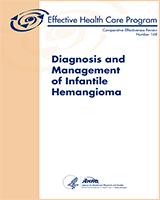NCBI Bookshelf. A service of the National Library of Medicine, National Institutes of Health.
Chinnadurai S, Snyder K, Sathe N, et al. Diagnosis and Management of Infantile Hemangioma [Internet]. Rockville (MD): Agency for Healthcare Research and Quality (US); 2016 Jan. (Comparative Effectiveness Reviews, No. 168.)
Table G-1Applicability of studies assessing imaging modalities
| Domain | Description of applicability of evidence |
|---|---|
| Population | Infants with hemangiomas (with mean ages of 30 days and 34 weeks). Fair distribution of male and female patients. |
| Intervention | Radiologic evaluation of hepatic hemangioma to determine which lesions required intervention and radiologic evaluation of lumbosacral cutaneous hemangiomas to evaluate which were associated with occult spinal dysraphism |
| Comparators | Comparators included ultrasound, magnetic resonance imaging, computed tomography and angiography. If different modalities were utilized on the same patient, it was sometimes not at the same time point making comparison between methods difficult. |
| Outcomes | Studies assessed imaging and clinical findings and with need for intervention for hepatic hemangiomas and the second study reviewed incidence of occult spinal dysraphism found in patients with lumbosacral hemangioma |
| Setting | Studies were conducted in the US, Canada and Spain at tertiary care centers with referral programs for hemangiomas/vascular malformations |
Table G-2Applicability of studies assessing steroids
| Domain | Description of applicability of evidence |
|---|---|
| Population | Infants and children with IH (ages ranging from less than one to 72 months). Typically more females. |
| Intervention | Corticosteroids including topical, intralesional, intravenous, and oral forms. |
| Comparators | Comparators included another steroid or observation. |
| Outcomes | Studies generally assessed change in lesion size and/or appearance and rebound growth. Two studies assessed vision outcomes. Comparative studies and case series also reported harms. |
| Setting | One comparative study was conducted in Canada and the others in the Netherlands, Germany, Turkey, Pakistan, and India. Applicability of some findings may be limited given differences in the systems of care in lower resource countries. Several comparative studies were also published between 2001 and 2010 and may not reflect current standards of care. |
IH-infantile hemangioma
Table G-3Applicability of studies assessing beta-blockers
| Domain | Description of applicability of evidence |
|---|---|
| Population | Studies typically included infants of both sexes ages 1 to 12 months of age (range: 1 month to 9 years of age) with infantile hemangiomas which included superficial, deep, and mixed lesions primarily involving the head and neck and occurring as focal or segmental lesions. |
| Intervention | Patients were treated with a variety of beta-blockers including propranolol at various doses and administrations (oral, intralesional, or topical), timolol (topical), atenolol (oral), or nadolol (oral) for a variety of treatment durations most commonly up to 6 months duration. |
| Comparators | Comparators included other formulations of the same beta-blocker, other beta-blockers, untreated historical controls, treated historical controls, and non-beta-blocker comparators (topical imiquimod, oral and intralesional steroids, laser, and intralesional bleomycin). |
| Outcomes | Studies commonly assessed final response based on size, volume, and/or coloration of IH, resolution of ulceration if present at initiation of therapy, and visual acuity or resolution of ptosis for periocular lesions. Assessments were obtained throughout therapy but final outcome assessments were typically performed following 24 weeks of treatment. Additional assessments for serious harms including bronchial hyperreactivity, hypoglycemia, bradycardia, and hypotension and less severe harms including sleep disturbances, cold extremities, and gastrointestinal complaints were monitored in the majority of studies. |
| Setting | Studies were conducted globally, often in speciality referral centers. |
IH-infantile hemangioma
Table G-4Applicability of studies assessing surgical and laser studies
| Domain | Description of applicability of evidence |
|---|---|
| Population | Studies typically included infants of both sexes, with preponderance of females ages 1 week to 43 years of age with superficial and cutaneous infantile hemangiomas in varied locations. |
| Intervention | Patients were treated with a variety of lasers including pulse dyed, Nd:YAG, argon, cryotherapy, and intense pulsed light photothermolysis; in most cases, lasers were used as first-line treatment, which is not general, current clinical practice. Some studies used laser in combination with a beta-blocker like timolol or propranolol or combined laser modalities. |
| Comparators | Comparators included other lasers, different pulse lengths, different cooling regimens, and observation. |
| Outcomes | Studies commonly assessed final response based on size, volume, and/or coloration of IH. Harms associated with laser treatment included skin atrophy, bleeding, scarring, ulceration and pigment changes. |
| Setting | Studies were conducted in the United States, United Kingdom, Netherlands, Germany, Greece, Japan and Singapore, typically in referral centers. |
IH-infantile hemangioma
- Applicability Tables - Diagnosis and Management of Infantile HemangiomaApplicability Tables - Diagnosis and Management of Infantile Hemangioma
Your browsing activity is empty.
Activity recording is turned off.
See more...
